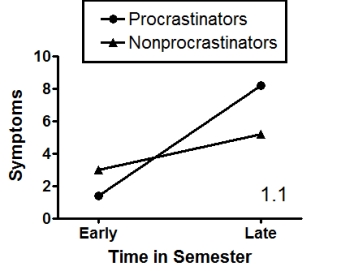Multiple Choice
Scenario I
Scenario I is based on and presents fabricated data consistent with the following study:
Tice, D. M., & Baumeister, R. F. (1997) . Longitudinal study of procrastination, performance, stress, and health: The costs and benefits of dawdling. Psychological Science, 8(6) , 454-458. doi:10.1111/j.1467-9280.1997.tb00460.x
Tice and Baumeister (1997) studied the relationship between procrastination and symptoms of physical illness in college students during an academic semester. Participants completed a questionnaire measuring procrastination. From this, they were classified as either procrastinators or nonprocrastinators. All participants also were instructed to record the number of negative health symptoms that they experienced during the first (early) and last (late) month of the semester. Figure 1.1 shows the major results of the study.
Figure 1.1 
-(Scenario I) The claim that students tend to procrastinate because most of the time there are no negative consequences for doing so is consistent with the school of psychology developed by:
A) Sigmund Freud.
B) E. O. Wilson.
C) B. F. Skinner.
D) Wilhelm Wundt.
Correct Answer:

Verified
Correct Answer:
Verified
Q2: Scenario I<br>Scenario I is based on and
Q3: Scenario II<br>Scenario II is based on and
Q4: Scenario II<br>Scenario II is based on and
Q5: Scenario II<br>Scenario II is based on and
Q6: Scenario I<br>Scenario I is based on and
Q7: Scenario II<br>Scenario II is based on and
Q8: Scenario I<br>Scenario I is based on and
Q9: Scenario I<br>Scenario I is based on and
Q11: Scenario II<br>Scenario II is based on and
Q12: Scenario I<br>Scenario I is based on and